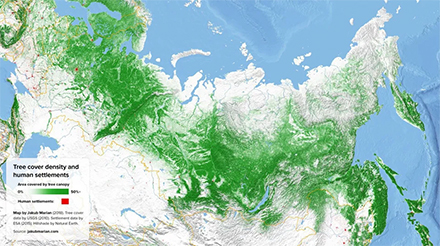Russia is home to enormous forest areas: approximately 800 million hectares, which can be compared with the area of New York City multiplied by ten thousand, or 5% of the total land area of planet Earth. The Russian pristine taiga alone is greater than the Amazon Rainforest. Source: Timberbiz
The Russian forests range from boreal to subtropical and are home to about 640 billion trees of over 200 species and contain almost one third of all global biodiversity of fungi.
They play an important role in mitigating global climate change and act as a huge sink of organic carbon. These wonderful ecosystems host over 250 million hectares of intact forest landscapes – mosaics of forest and naturally treeless ecosystems, which show no remotely-detected signs of human activity or habitat fragmentation, large enough to maintain native biological diversity.
Intact forest landscapes have a high conservation value and are critical for harbouring biodiversity, regulating water regimes, and providing other ecosystem functions. However, the increasing demand for Russian timber from Europe, China, North Africa and the Middle East is putting pressure on these precious forests.
The production of sawn wood for export, which is just one among several wood products, is expected to increase about 40 million cubic meters from five years ago to as much as 70 million cubic meters in 2030. The intact forest landscapes and other forest areas of high conservation value are under threat wherever sustainable forest management is not in practice.
With Russia ranking high in terms of integrity risk, an approach to mitigate the identified risks is needed whenever wood or forest-based products enter the FSC supply chain. With new FSC standards that came into force in March, all FSC-certified forests are subject to stricter controls. Forest managers must set aside up to 80% of the intact forest landscape to preserve their biodiversity.
From next year onwards, no harvesting will be allowed in the newly certified intact forest landscapes, with only a few exceptions. In addition, when it comes to preserving forests of high conservation value, such as intact forest landscapes, all stakeholders with an interest in that forest, including Indigenous Peoples, must be engaged.
Special attention must be given to biodiversity conservation during harvesting, where specific measurable indicators verified every year set the bar for FSC-certified forest management units.
At least 10% of the original forest must be retained in clear cut areas (clear cutting is a common practice for obtaining timber in boreal forests). The retained forest is a habitat where it is likely that rare, threatened, vulnerable and endangered species occur.
The new standard further strengthens the work of FSC in Russia, that led to the establishment of two new national parks, two regional protected areas and the protection of over 600 000 hectares of the most ecologically valuable intact forest landscapes.
There are still many challenges that put the forests of Russia at risk. One of them is sanitary (or salvage) logging, which is an important forest management practice to maintain forests in good health. It consists of felling of infected or dead trees, when these are affected by pests, diseases, wind or fire.
However, sanitary logging is sometimes carried out illegally in Russia. This happens when companies obtain a permit via illegal means or conduct salvage logging in violation of legislation. Examples of these infringements include logging broader areas than defined in the permit, logging healthy trees, or having authorities issue a permit without good reason.
FSC is urgently developing measures to combat this practice where this is in FSC’s remit and scope, and raises the issue with other key stakeholders to do their part. Firstly, FSC is working with certification bodies to strengthen the control over the sanitary logging processes.
Secondly, FSC is cooperating with the Federal Forestry Agency to make the information about sanitary wood more transparent.
Thirdly, FSC is leading studies to understand the scale of the problem and the loopholes, and to find ways of addressing them through the revision of its standards and processes.
Some of these actions will deliver immediate results, others will trigger further awareness and debate, and may take longer to lead to visible change. From facilitating field workshops with certification bodies to hosting events with environmental and social NGOs, Indigenous Peoples, and various experts, FSC is actively seeking different perspectives to solve issues and create a better future.






